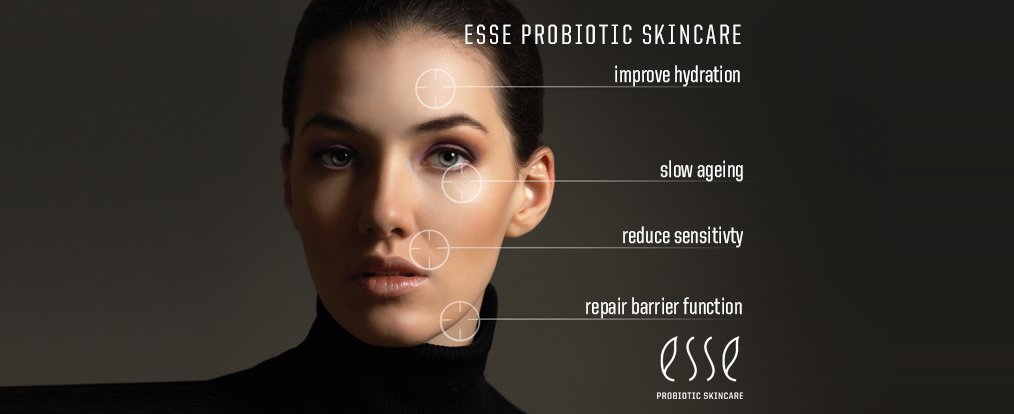WHAT IS A PROBIOTIC IN SKINCARE? August 2, 2017 – Posted in: Beauty
Every few decades, a scientific discovery is made that changes the way that we see ourselves and the world around us.
With the discoveries made by the Human Microbiome Project, it is now clear that skin is an ecology, with more than 10 microbes for every human cell. These microbes are essential to the optimal functioning of skin and current skincare regimes ignore this basic fact.
The advances in genetic sequencing over the last 10 years have also allowed scientists to distinguish human DNA from that of other organisms. The results are revolutionising the thinking on human health.
Each one of us is a complex ecosystem – a harmonious mix of human cells and microbes. These microbes are an essential part of you and contribute strongly to your wellbeing.
The Human Microbiome Project has revealed that highly complex microbial interactions are prevalent in the skin. Microbes defend and protect the skin from pathogens, they maintain effective barrier function, and they prevent premature ageing.
Probiotics are microbes that are good for you and prebiotic is a “food” that favours the growth of these microbes. Probiotics can shift the skin’s ecology to favour a diverse and harmonious ecosystem that is healthy enough to resist attacks from pathogens and to reduce the impacts of ageing on the skin.
Esse Probiotic Skincare have developed probiotic products that maintain an optimal balance of microbes to slow the ageing process. We aim to create an environment on the skin that favours the growth of beneficial microbes so that they can out-compete pro-ageing species. To do this, we use prebiotics to selectively feed good microbes and have included probiotic microbes in some of our products to actively change the microbial mix on the skin.
We use mild preservatives, gentle surfactants, and we keep the pH of our products between 4 and 5. We also pay particular attention to preventing the pollution of the skin’s ecosystem with synthetic chemicals and our products are certified organic by Ecocert.
We believe that mindful products are a step towards an indefinitely sustainable, richly varied, and beautiful future.
In the food industry, it’s easy to define a probiotic – it is a live microbe that has a health benefit. Probiotics in food are measured in colony forming units per millilitre (cfu per ml) and this shows how many microbes per millilitre of product can start to grow and replicate when the product is used.
In skin care defining a probiotic is not as easy.
Incorporating live probiotics into conventional skincare products is not generally feasible. Most products contain water, and preservatives are required to prevent spoilage. These preservatives, by definition, kill microbes – so the probiotic cfu per ml would be zero.
There are, however, plenty of probiotic claims in the skin care world. These claims are justified in several different ways and there seem to be four “levels” to these claims.
Level 1 (lowest)– These products use the “broth” from a microbial soup. The microbes are grown on a substrate (think of this as a watery solution of microbial nutrients) and then the probiotic microbes are filtered off. The “broth” is the remaining solution (which has the products of the microbes in it.) This is used as an ingredient in a final cosmetic product. Good skin care results can sometimes be obtained using this technique, but Esse does not refer to this technology as “probiotic”.
Level 2 – These probiotic extracts are called lysates because the probiotic cells are ruptured – obviously killing them in the process. In this technique, the probiotics are again cultured in a nutrient-rich substrate but instead of filtering them off, the cells are broken so that their cell contents leak out before the mixture is filtered. This method results in an “extract” that contains the cytoplasm (cell contents) of probiotic microbes. Esse uses this technology in the majority of its products and (for now) we do refer to this type of ingredient as a probiotic. We have seen brands with probiotic claims using level 1 and level 2 ingredients in their products.
Level 3 – In this technique, the microbes are kept whole but they are killed with heat. This process is called tyndallisation and here the culture of probiotics is heated to 60 °C and cooled again over three days. These probiotics can still dock onto skin cells but obviously can’t grow and divide to significantly alter the skin’s microbiome. Esse uses this technology in the Ageless Serum and the Toner Plus and we do refer to this type of ingredient as probiotic – for the moment.
These three levels of probiotic supplementation are relatively easy to produce. The ingredient is simply added to the formulation at the end of the manufacturing process with no real change in the preservative system or in the rest of the product.
Level 4 (highest) – This is the technique that Esse is doing. Level 4 is the incorporation of live probiotic microbes in the final product. There are a number of difficulties in this process. Firstly, the use of a preservative system would kill the microbes, so the product needs to be preservative free. Secondly, it is exceedingly difficult to ensure that the probiotics are not killed during the production process. Thirdly, there are storage considerations for the final product … if the temperature drops too low, then the water in the probiotic cells will freeze and, because water expands when it freezes, the cell membrane of these cells will break and most of the cells will die. If the temperature rises above 40 °C, the enzymes in the live cells will start to denature and, again, most of the probiotics will die.
Esse has overcome these challenges and the Esse Probiotic Serum uses level 4 probiotics – it contains one billion live probiotics per millilitre. There are three different species of Lactobacillus in the symbiotic mix. We have shown that the product is pathogen-free and that the microbes remain capable of growth for two years from production.
Source : http://www.esseskincare.com/en-za/probiotic-skincare.html

